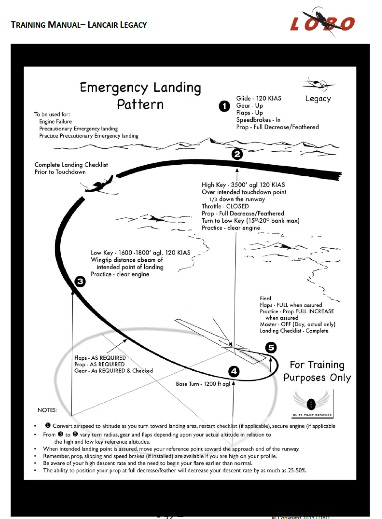
We are working on the details and will let you know what is organised before long. Suggestions/requests welcome.

Yes, it is Mothers’ Day weekend, so why not bring Mum along to enjoy the weekend with us and our LOL’s (LOBO Oz Ladies)?


Knowledge is Life
If our most recent study of Lancair accidents tells us anything, it demonstrates that GA pilots—and especially Lancair pilots—need to reexamine our understanding of our aircraft, the environment we fly in and ourselves, with an eye toward raising the bar and furthering our knowledge in all these areas. Do not be content to just kick the tires and light the fires and have a good day of flying. Accept the idea that at any time the engine could quit, the landing gear could remain in the well or the weather could worsen. What are you going to do in that event? I urge you to follow Col. Glenn’s example (and FAR requirements) and know everything necessary to complete the mission safely. Study the POH, review FAA literature, attend FAAST safety seminars and LOBO Landings for more training specific to your operations.
Over twenty years ago I wrote an article about emergency landing procedures which was published in the American Bonanza Society Magazine. It referenced the Bonanza training guide and T-34B NATOPS Manual for technical details. The article showed how it’s possible to experience an engine failure and glide to a successful landing on a runway or other suitable site within your glide range distance. The Lancair fleet of aircraft have excellent glide characteristics (for example: the IVP has a glide ratio of nearly 20:1 and the Evolution 18:1) IF THE AIRCRAFT IS FLOWN PROPERLY!
Here are a few thoughts to consider when experiencing an engine failure:
1.Remain calm! It does no good to cry like a baby or get old-timer’s syndrome at this moment. At the end of this event your passengers will either believe you were Chuck Yeager with nerves of steel or Bozo the Clown.
2.PERFORM THE IMMEDIATE ACTION CHECKLIST STEPS THAT YOU HAVE COMMITTED TO MEMORY.
3.Maintain control of the aircraft! The aircraft will fly fine without power—it is now a very expensive glider. LOSING CONTROL IS BAD—DO NOT STALL!
4.Maintain altitude if you are above best glide speed (110 KIAS in the Evo or 120 KIAS in the IVP and Legacy or 100Kts for our L320/360) until you reach best glide speed—then maintain best glide speed. This is precious energy do not give it away! Reduce drag—gear up, flaps up, feather the propeller if possible. If you cannot feather the prop pull the control all the way aft to high pitch (low RPM) position. Keep the gear and flaps up and prop feathered/set to full high pitch until you are ready to land.
5.Turn to nearest airport or other suitable landing site. Assuming you’ve maintained a modicum of situational awareness and know where the hell you are, you should already know where that is. If not, press the NRST button on your GPS. Do not accept ATC vectors away from your chosen landing; the controller is not going to be with you at the landing site.
6.Attempt a restart if you have time and believe the engine might be capable of running. If not secure all fuel sources. Turn off all electrical sources—to eliminate any source of sparks—after putting the gear and flaps down in the pattern.
7.Fly to and arrive overhead the airport, then spiral down in a medium banked turn. Plan to arrive at high and low key positions at the correct airspeed as you were taught.
8.Maintain control of the aircraft! The aircraft will fly fine without power—it is now a very expensive glider. LOSING CONTROL IS BAD—DO NOT STALL!
9.Many engine out approaches end with a stall close to the chosen landing site because the pilot either ran out of energy before the touchdown zone and tried to extend the glide, got too steep in the turn to final and stalled or overshot the landing zone and stalled off the end. The best way to avoid this phenomenon is to practice—a lot!
10.Land smoothly on the runway. Do not expect your significant other to get back in the airplane any time soon if you screw this up.
Except for the engine and propeller comments—the rest is straight out of the glider pilots handbook.
Remember: One day you will be a glider pilot. Are you ready?
For questions and comments on this post contact Jeff via email: j.edwards@lancairowners.com.
One of the founding principles of LOBO OZ is an emphasis on safety – to enhance the joy of flying. All of those involved in setting up LOBO OZ thoroughly enjoy the experience of flight, but within the management of all those factors which the general public see as risky (and other factors of which the general public may be unaware).
It is hoped that by sharing experiences, we can all learn something from the experience of others, and contribute to the (sometimes) steep learning curve pilots may face moving into an ‘Experimental’ category aircraft – especially if it is an owner/builder project.
All in all, we have invested much time and money in making our aircraft as safe as possible. Indeed, the majority of our Lancairs make certified aircraft look obsolete in finish, avionics and performance.
Thus, we also need to take this safety-oriented thinking & apply it to our flying.
This is an excerpt from the latest newsletter, which continues an article from Gary Burns, discussing the test flying of his Lancair IV, and threat and error management. Available here.
Contributions to future newletters/ articles or blog posts are welcome from members. Send to contributions – we would love to feature members’ projects and photos of finished aircraft. So please get in touch!